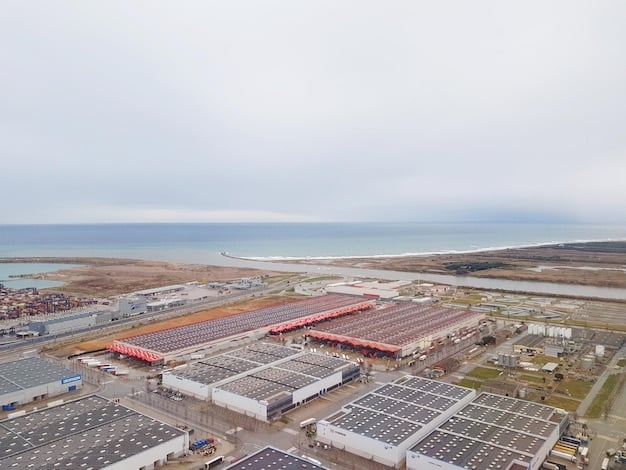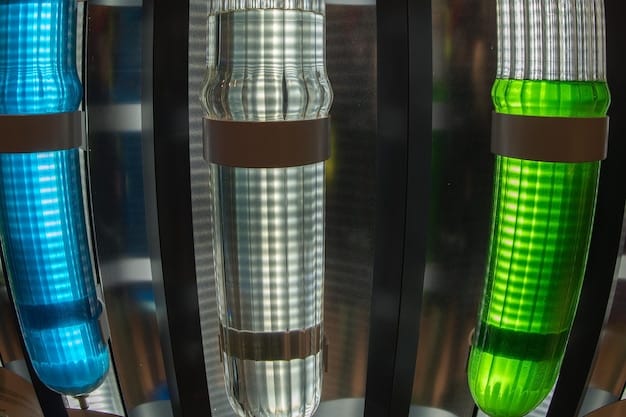Renewable Energy Storage: Transforming the US Energy Grid

Recent advancements in renewable energy storage technologies, including lithium-ion batteries, flow batteries, and thermal storage, are crucial for enhancing the reliability and efficiency of the US energy grid by addressing the intermittency of renewable sources like solar and wind power.
The integration of renewable energy sources is rapidly changing the landscape of energy production in the United States. However, the inherent variability of solar and wind power presents a significant challenge: reliable energy storage. This article explores what are the latest developments in renewable energy storage technologies and their potential to transform the US energy grid, making renewable energy a consistently dependable power source.
Understanding the Need for Advanced Energy Storage
The transition to renewable energy is not just about generating clean power; it’s also about ensuring that this power is available when and where it’s needed. This is where advanced energy storage technologies come into play. They are essential for smoothing out the variable output of renewables and providing a stable, reliable energy supply.
Why Energy Storage is Critical
Energy storage technologies address the fundamental challenge of intermittency associated with renewable sources like solar and wind. When the sun isn’t shining or the wind isn’t blowing, these sources can’t generate electricity. Energy storage bridges this gap, storing excess energy during peak production periods and releasing it when demand is high or production is low.
- Enhancing Grid Reliability: Energy storage systems can quickly respond to fluctuations in demand, preventing blackouts and maintaining grid stability.
- Reducing Curtailment: Instead of curtailing excess renewable energy production, storage allows us to capture and use this energy later.
- Enabling Greater Renewable Penetration: With robust storage solutions, the grid can handle a higher percentage of renewable energy without compromising reliability.
Ultimately, energy storage is the key to unlocking the full potential of renewable energy and creating a more sustainable and resilient energy system.

Lithium-Ion Batteries: The Current Frontrunner
Lithium-ion (Li-ion) batteries have become the dominant technology in energy storage due to their high energy density, relatively long lifespan, and declining costs. They are widely used in electric vehicles and are increasingly being deployed in grid-scale storage projects.
Advantages of Lithium-Ion Batteries
Li-ion batteries offer several advantages that make them well-suited for grid-scale energy storage. Their high energy density means they can store a significant amount of energy in a relatively small space. They also have a high charge and discharge efficiency, minimizing energy losses during storage and retrieval.
Limitations and Ongoing Research
Despite their advantages, Li-ion batteries also have limitations. They can be expensive, and their lifespan is limited by degradation over time. There are also concerns about the safety of Li-ion batteries, as they can be prone to overheating and fires under certain conditions. Ongoing research is focused on improving the safety, cost, and lifespan of Li-ion batteries.
Li-ion batteries represent a mature and effective technology, but continued innovation is crucial to overcome existing limitations and further optimize their performance for grid-scale applications.
Flow Batteries: A Promising Alternative
Flow batteries are an emerging energy storage technology that offers several advantages over Li-ion batteries, particularly for long-duration storage. Unlike Li-ion batteries, which store energy in solid electrodes, flow batteries store energy in liquid electrolytes.
How Flow Batteries Work
Flow batteries consist of two tanks of electrolytes that are pumped through a cell stack, where electrochemical reactions occur to charge and discharge the battery. The amount of energy that can be stored is determined by the size of the electrolyte tanks, while the power output is determined by the size of the cell stack.
Advantages of Flow Batteries
Flow batteries offer several key advantages. They have a long lifespan, with some systems capable of operating for 20 years or more. They are also inherently safer than Li-ion batteries, as the electrolytes are non-flammable. Furthermore, flow batteries can be scaled independently in terms of energy and power, making them highly flexible for different applications.
- Long Duration Storage: Flow batteries excel at storing energy for extended periods, making them ideal for balancing the variability of renewable energy sources.
- High Scalability: The modular design of flow batteries allows for easy scaling to meet specific energy storage needs.
- Enhanced Safety: The use of non-flammable electrolytes reduces the risk of thermal runaway and fires.
Flow batteries are poised to play an increasingly important role in the energy storage landscape, particularly for applications requiring long-duration storage and high scalability.
Thermal Energy Storage: Leveraging Heat and Cold
Thermal energy storage (TES) technologies store energy in the form of heat or cold. These systems can be used to store energy from renewable sources like solar thermal and geothermal or to store waste heat from industrial processes.
Types of Thermal Energy Storage
There are several types of TES technologies, including sensible heat storage, latent heat storage, and thermochemical storage. Sensible heat storage involves storing energy by heating or cooling a material, such as water, oil, or rocks. Latent heat storage involves storing energy by changing the phase of a material, such as melting ice or solidifying a salt.
Applications of Thermal Energy Storage
TES can be used for a variety of applications, including district heating and cooling, industrial process heating, and power generation. For example, a solar thermal power plant can use TES to store energy during the day and generate electricity at night. TES can also be used to store waste heat from industrial processes, reducing energy consumption and greenhouse gas emissions.

Thermal energy storage represents a cost-effective and environmentally friendly way to store energy, offering significant benefits for a range of applications.
Compressed Air Energy Storage: Utilizing Underground Reservoirs
Compressed Air Energy Storage (CAES) is a technology that stores energy by compressing air and storing it in underground reservoirs, such as salt caverns or depleted natural gas fields. When energy is needed, the compressed air is released and used to drive a turbine, generating electricity.
How CAES Works
CAES plants typically consist of an air compressor, an underground reservoir, and a turbine. During periods of low electricity demand, the compressor uses electricity to compress air and store it in the reservoir. During periods of high electricity demand, the compressed air is released and heated, then used to drive a turbine to generate electricity.
Advantages and Challenges of CAES
CAES offers advantages such as large-scale energy storage capacity and long lifespan. However, it also faces challenges, including the need for suitable geological formations for underground reservoirs and the dependence on fossil fuels to heat the compressed air.
- Large-Scale Storage: CAES systems can store large amounts of energy, making them suitable for grid-scale applications.
- Long Lifespan: CAES plants can operate for decades, providing a long-term energy storage solution.
- Geographical Limitations: The availability of suitable underground reservoirs limits the deployment of CAES technology.
CAES remains a viable option for large-scale energy storage, particularly in regions with suitable geological formations, but ongoing research is focused on improving its efficiency and reducing its reliance on fossil fuels.
Hydrogen Storage: A Future Energy Carrier
Hydrogen storage is an emerging technology that involves storing energy in the form of hydrogen. Hydrogen can be produced from renewable sources like solar and wind through electrolysis, and then stored for later use in fuel cells or combustion turbines.
Methods of Hydrogen Storage
There are several methods of hydrogen storage, including compressed gas storage, liquid hydrogen storage, and solid-state storage. Compressed gas storage involves storing hydrogen at high pressure in tanks. Liquid hydrogen storage involves cooling hydrogen to extremely low temperatures to liquefy it. Solid-state storage involves storing hydrogen in solid materials, such as metal hydrides or carbon nanotubes.
Potential of Hydrogen Storage
Hydrogen storage has the potential to play a significant role in the future energy system. Hydrogen can be used to power vehicles, generate electricity, and provide heat for buildings. It can also be used as a feedstock for industrial processes.
Hydrogen storage is still in the early stages of development, but ongoing research is focused on improving the efficiency, cost, and safety of hydrogen storage technologies. As these technologies mature, hydrogen is expected to become an increasingly important energy carrier.
| Key Point | Brief Description |
|---|---|
| ⚡ Li-ion Batteries | Dominant tech, high energy density, declining costs. |
| 💧 Flow Batteries | Promising alternative, long lifespan, safer, scalable. |
| 🔥 Thermal Storage | Stores heat/cold; useful for solar thermal, industry. |
| 💨 CAES | Large-scale storage, compressed air in reservoirs. |
Frequently Asked Questions
▼
The primary challenge is their intermittency. Solar and wind power generation varies with weather conditions, making it difficult to ensure a consistent power supply.
▼
Energy storage systems store excess energy generated during peak production times and release it when production is low or demand is high, ensuring a stable supply.
▼
The main types include lithium-ion batteries, flow batteries, thermal energy storage, compressed air energy storage (CAES), and hydrogen storage.
▼
Li-ion batteries are popular due to their high energy density, relatively long lifespan, and declining costs, making them suitable for grid-scale and EV applications.
▼
Future developments include advancements in flow batteries for long-duration storage and hydrogen storage technologies for use as an energy carrier.
Conclusion
The latest developments in renewable energy storage technologies are paving the way for a more reliable, efficient, and sustainable US energy grid. From advancements in battery technology to innovative thermal and compressed air storage solutions, these technologies are essential for integrating renewable energy sources and ensuring a secure energy future.





